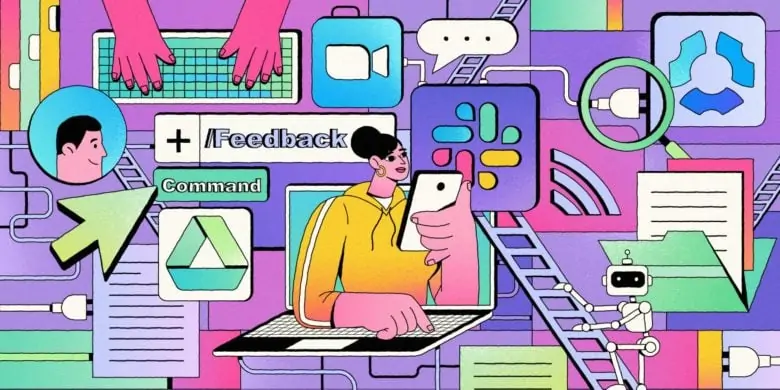Trello is a popular project management system for both businesses and freelancers. It’s based on the well known Kanban methodology to help you easily keep track of projects and create plans.
But just because it’s one of the most widely used task tracking apps doesn’t mean it’s the best fit for everybody. If you’re looking for Trello alternatives, you’re not alone.
Trello is a great planning tool, but it has some notable issues. Here are a few drawbacks mentioned by user reviews:
- There are several lacking features. There is no ability to set a time-stamp on a project (how long it will take) outside of using the calendar feature. You cannot assign an approximate time to complete a project. Also there is no messaging function, only “comments”
- There comes a point in every Trello board’s life when the user will go “ok, now it’s time to move this all away from Trello.” Task management is laborious at best, with no real way of tracking time, burndowns, productivity, velocity, or any other metric that tells a project manager if the job is getting done. It’s simply not built for that, and trying to implement methods that will make it work just results in frustration.
- We are a team of social media specialists and wish that Trello would integrate better with other social media scheduling tools such as Sprout Social and/or Salesforce.
Also, Trello recently announced that free teams will need to upgrade to at least a Business account to use more than 10 open boards.
In other words, you’ll have to pay for $12.50/month per user — previously $0 — if you have more than 10 projects. This is a big deal, especially for small businesses.
For these and many other reasons, lots of former users are actively looking for an alternative to Trello. We’ve put together a list of 9 project planning apps like Trello that might be a better fit for your team.
Boost your team’s efficiency with Hubstaff's productivity tools
9 Trello alternatives to consider
There are plenty of options if you’re looking for reliable, affordable, and powerful project management software. Here’s a roundup of the best Trello alternatives:
1. Hubstaff Tasks
Hubstaff Tasks is a Kanban tool that helps you effortlessly keep track of tasks, assign work to your teams, and maintain an efficient workflow that’s easy for your team to handle.
If you’re looking for a project management app that combines the best parts of Agile with a user-friendly interface, Hubstaff Tasks is the perfect solution for your team. Those looking for a Trello alternative will find Hubstaff Tasks compelling — and affordable.
Your team will find it much easier to use. You’ll find it much easier to check in on progress without interrupting work.
Hubstaff Tasks is intentionally simple, but unlike Trello, the simplicity doesn’t get in the way of functionality.
Project managers have better access to team data and more freedom to set up detailed, complex projects. It’s easy to link tasks, organize different workflows for different projects, and collaborate between teams.
Where Trello takes a one-size-fits-all approach, Hubstaff Tasks allows you to customize your approach to suit different teams and projects.
Your development team and your marketing team don’t work the same way, so they shouldn’t be forced to use the same task management process. Features like checklists and Sprint focus will be a refreshing change for departments that find it hard to work in Trello’s strictly Kanban environment.
Automation is another one of Hubstaff Tasks’ biggest strengths. Since you don’t have to spend so much time managing your software, you can focus on effectively managing your team.
Using the sprints feature, teams can focus on the highest priority tasks and get more done. Automated visual workflows move tasks through your defined process with the click of a button.

Hubstaff Tasks is ideal for teams who need a more intuitive way to track time and progress.
Combine Hubstaff Tasks with Hubstaff for a seamless way to manage your team’s projects and optimize their productivity. With time tracking, you can easily see which tasks and projects cost you the most and where your team might need more help.
Its features and ease of use make it an excellent overall choice for all kinds of organizations, and it’s an especially good choice for growing teams.
Key features:
- Organize Kanban card tasks with a simple drag-and-drop mechanism
- Easily collaborate with teammates through comments, tags, followers, assignees, and other intuitive communication features
- Set sprint tasks and duration so that your team knows what’s on their plate
- Create checklists within tasks for more detailed progress tracking
- Quickly access notifications when anyone tags you or assigns you to a task
- Easily integrate with Hubstaff so you can accurately track the time you spend on projects
Pricing:
All Hubstaff Tasks features are available for just $4/month per user when paid annually. There’s also a robust free plan for up to five team members.
With these features and a low monthly rate, Hubstaff Tasks is a great alternative for Agile project management.
Customer Rating in Capterra: 4.5/5
Customer Rating in G2: 5/5
2. Monday
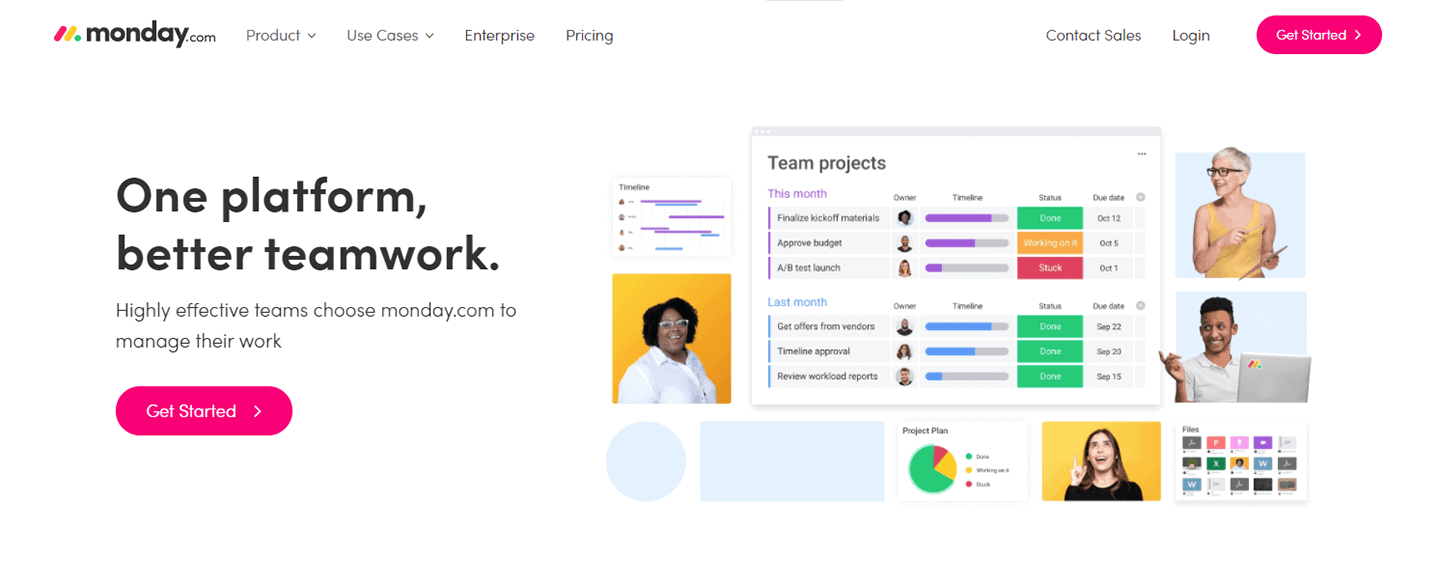
Monday helps teams stay on top of deadlines and can easily be used via mobile or desktop. It’s flexible, but still easy enough that your team won’t need extensive training to get started.
To stay flexible, Monday offers a variety of apps built on the product’s framework to add the features and functionality you need for your team. Teams can use the Monday Apps platform to create their own building blocks. You don’t even need to know much code to do it.
If you’re looking for a little less complexity, you can get started with a template instead of setting up your own workflow. Monday operates on a system of building blocks so you can drag and drop components and build flows visually.
Just like Trello suits a wide variety of teams and industries, Monday is a good fit for a lot of different teams. If you have a lot of people on your team that process information visually, especially if they’re a little more tech savvy, they’ll probably like this tool.
Key features:
- Capacity management
- Drag and drop workflow builders
- Robust search and filtering options
- Intuitive collaboration across teams
- Resource scheduling
Pricing:
Their pricing starts at $8.00 per month, per user. Monday does not have a free version, but does offer a free trial.
Customer Rating in Capterra: 4.6/5
Customer Rating in G2: 4.5/5
3. MeisterTask
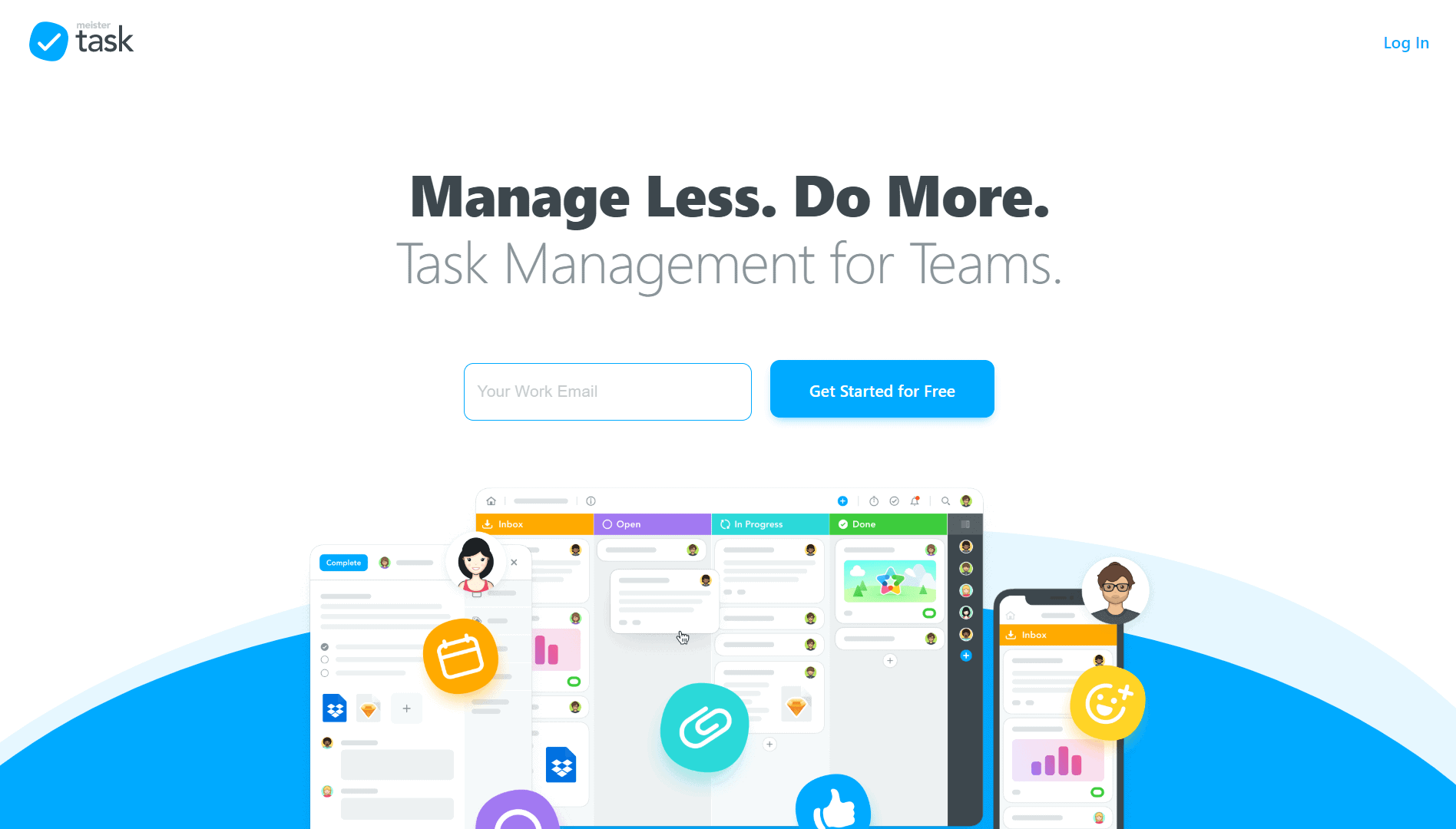
MeisterTask is a cloud-based project management tool with a Kanban-style interface. It’s supported on Windows, Mac, Android, and iOS.
The interface is visually appealing and thoughtfully designed. Like some of the other tools on this list, MeisterTask is kept intentionally simple so that users can focus on the most important features without getting confused by extras they don’t need.
There’s an easy import option for current Trello users, so switching is quick.
MeisterTask is a good choice for teams looking for a simple, straightforward Trello alternative, especially if you’re trying to stay on a free plan.
Key features:
- Easy, simple workflows
- Notes and attachments on Kanban cards for easy access
- Task relationships to help identify key tasks at the moment
- Workflow automations to help smooth out the flow of work
Pricing:
The Basic plan is free. If you need integrations, automations, and other more sophisticated features, the Pro plan starts at $8.25 per month. Collaboration between free and paid accounts is permitted on MeisterTasks, so you can give each member of your team the specific tool they need at the right price.
Customer Rating in Capterra: 4.7/5
Customer Rating in G2: 4.6/5
4. Aha!
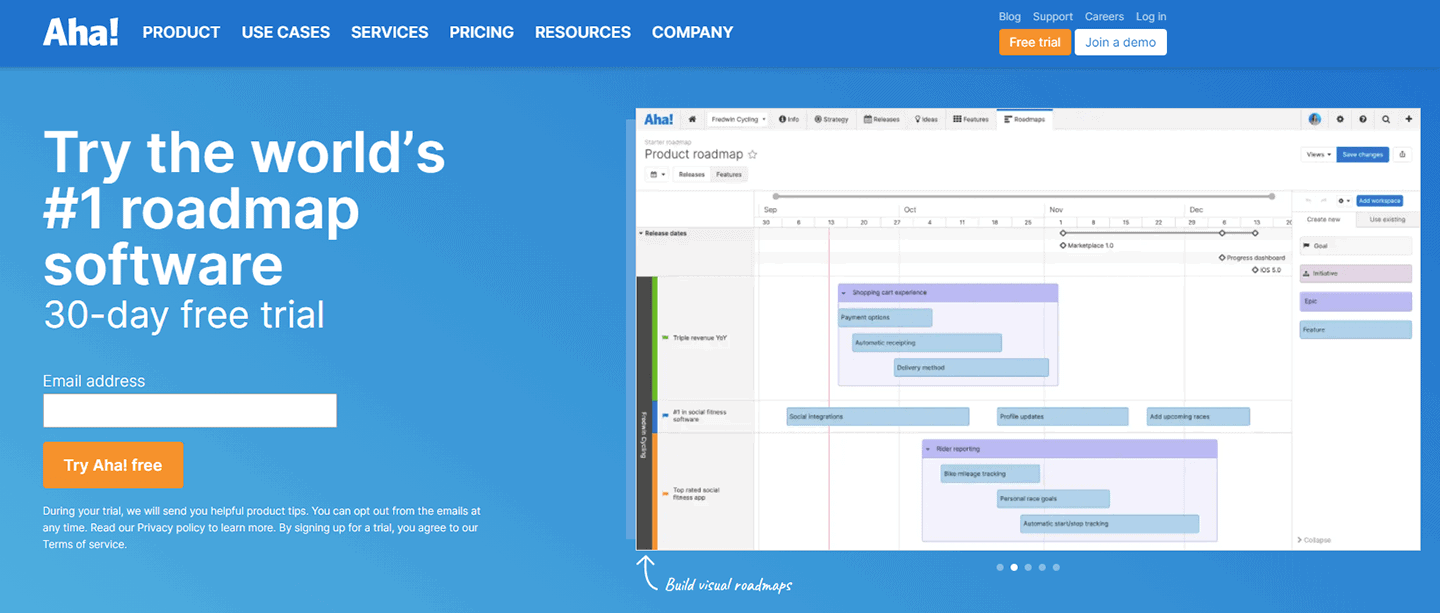
Aha! is a product roadmap software that works like a flow chart. You input goals and objectives that are linked to create a strategy for a project. Then, you can visually see what’s required on the project to meet the end goal.
If you currently use Gantt charts to manage your projects, you’ll like the Aha! interface. It’s a good alternative for teams who want to move away from the more common Kanban board style of project management.
The Aha! ideas portal is a great tool for brainstorming as a team, even if you can’t all be in the same place at the same time.
Aha! works great for software teams and anyone who likes to start with the goal in mind. There are specialized interfaces for marketing, IT, product development, and business operations, too.
Key features:
- Color-code your tasks and projects for easier visual organization
- Capture customer feedback within the system even if a customer is not an Aha! user
- Convert plans into charts for easier analysis
- Share plans or data via PDF, Intranet, or the internet
- Record notes from meetings and assign team members to action tasks
Pricing:
The Startup plan comes with the Premium plan’s features, but is limited to a total of five users. You must meet their qualifications as an early stage company to get it for free.
The other plans run from $59 – $149 per user month depending on your needs. It’s a little steep, but since the software is specialized for product development, it offers features you won’t find in programs like Trello.
Customer Rating in Capterra: 4.8/5
Customer Rating in G2: 4.3/5
5. Taskworld
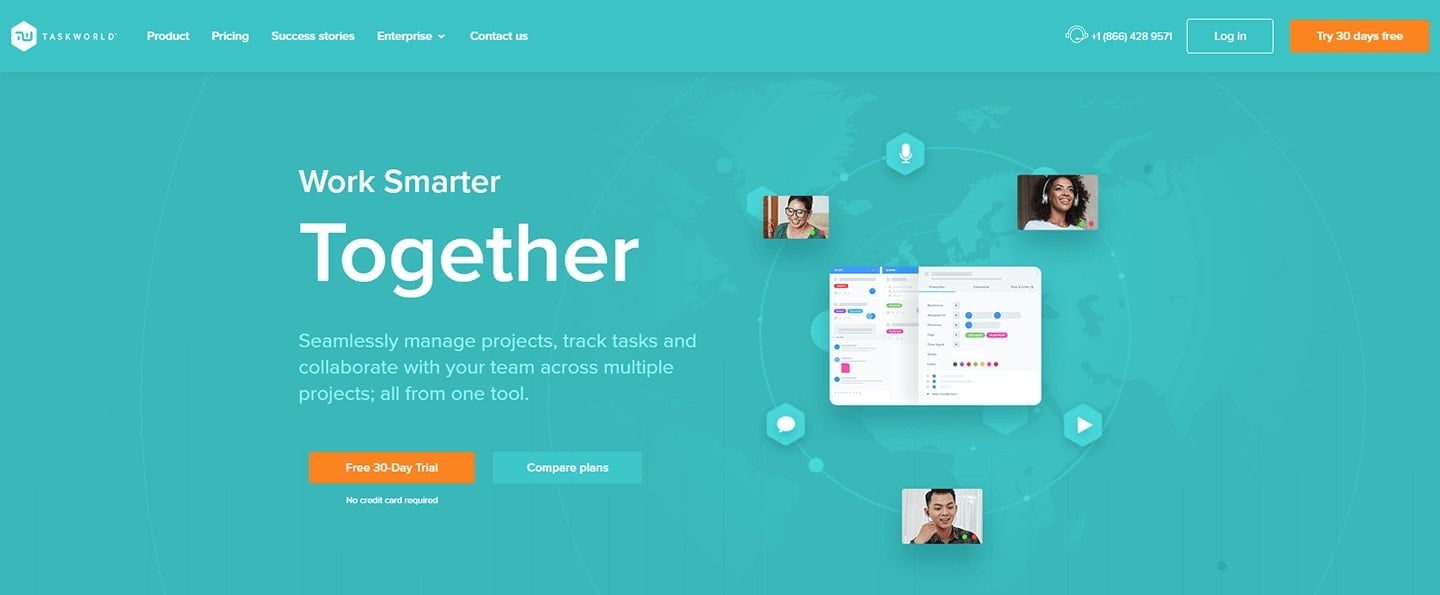
Taskworld began in 2006 when Fred Mouawad was struggling to grow some of his companies. He wanted a solution to organize tasks; thus, Taskworld was born.
This tool is flexible and easy to use with a strong focus on team performance. It’s designed to handle communication, reporting, task management, and basic monitoring all in one place. You can track your team’s progress with visual timelines that are based on Gantt charts.
To help you get onboarded easily, Taskworld offers demos and workshops in addition to their 24 hour support.
Taskworld is great for software teams, developers, and other teams that manage complex projects. It’s a good choice for teams with employees working on overlapping projects.
Key features:
- Create tasks, set due dates, and monitor progress with interactive boards
- Add multiple project locations within one task
- Drag and drop files in a message, comment or task
- Send messages and files to team members directly
- Progress bars to show how much of projects are completed
Pricing:
Plans start at $10/user per month. This includes unlimited tasks and guests, task followers, privacy settings, 100 GB of storage, and more.
Customer Rating in Capterra: 4.7/5
Customer Rating in G2: 4.5/5
6. Asana
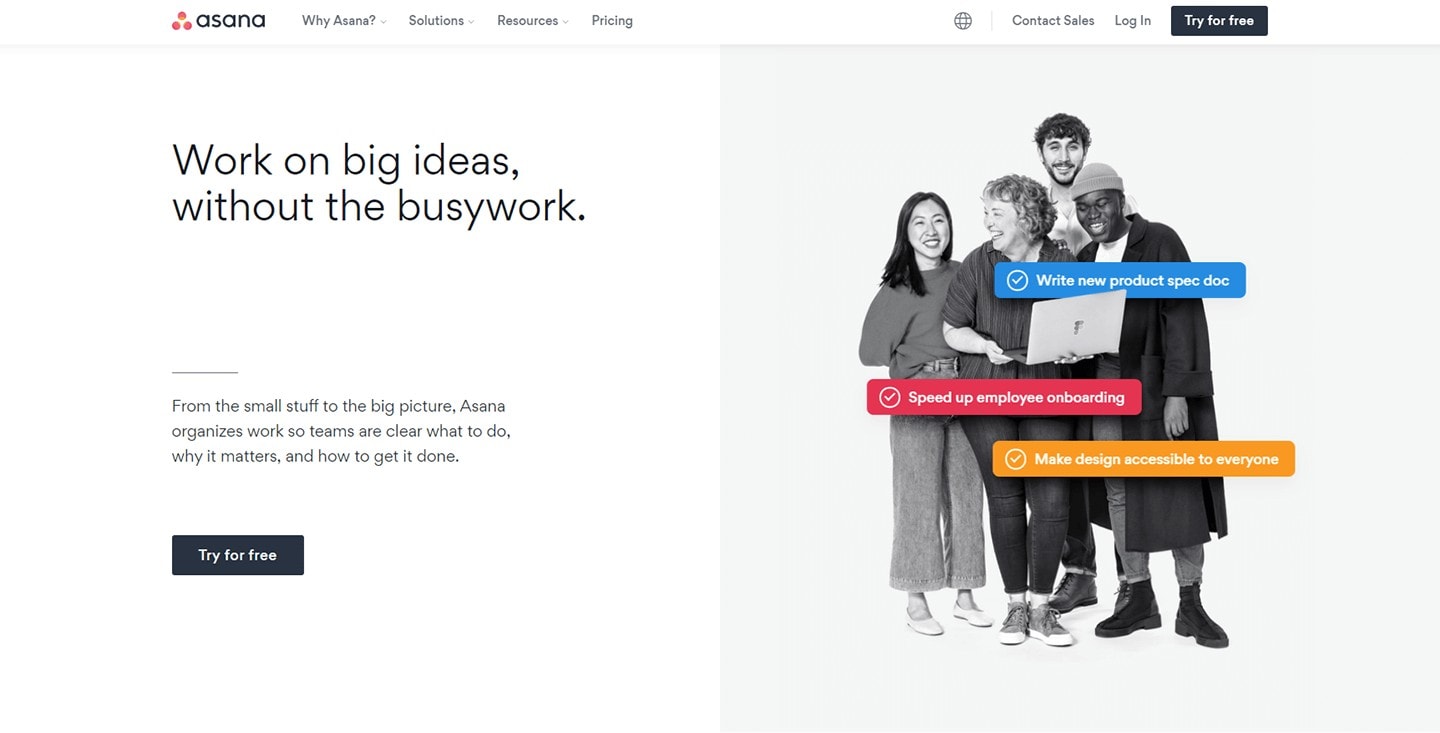
Asana is a top collaboration and project management tool that gives teams a snapshot of key project tasks and deadlines.
A lot of teams find that it’s a bit confusing to get up and running, but once they do, it’s a great tool to keep projects running. While they do offer a new Timeline feature, it does not have a robust time tracking system like some of the other Trello alternatives on this list.
Asana is packed with other features, too.
The Forms feature helps your team manage work intake.
Portfolios help you track key initiatives so you can communicate with stakeholders and manage risk more effectively.
There are features to help you visualize your calendar, manage your team’s workload, and control access to sensitive information.
Asana is a powerful tool for larger teams with dedicated project managers to maintain the software. It can be a little too complicated for smaller teams who manage their own projects, though.
Key features:
- Robust administrative controls
- Workflow templates for easier automation
- Visual Kanban boards to easily move projects forward
- Timeline planning to see how your project fits together
- Calendar view to help spot overlaps and holes in your team’s schedule
Pricing:
Asana’s Basic plan is free, and the Premium account starts at $13.49 per person per month. You get a discount for paying annually, and small teams with fewer than 15 people are eligible for a discount on the Premium plan.
Customer Rating in Capterra: 4.4/5
Customer Rating in G2: 4.6/5
Kanban project management with time tracking
Try Hubstaff Tasks with Hubstaff for better productivity.
7. Quick Base
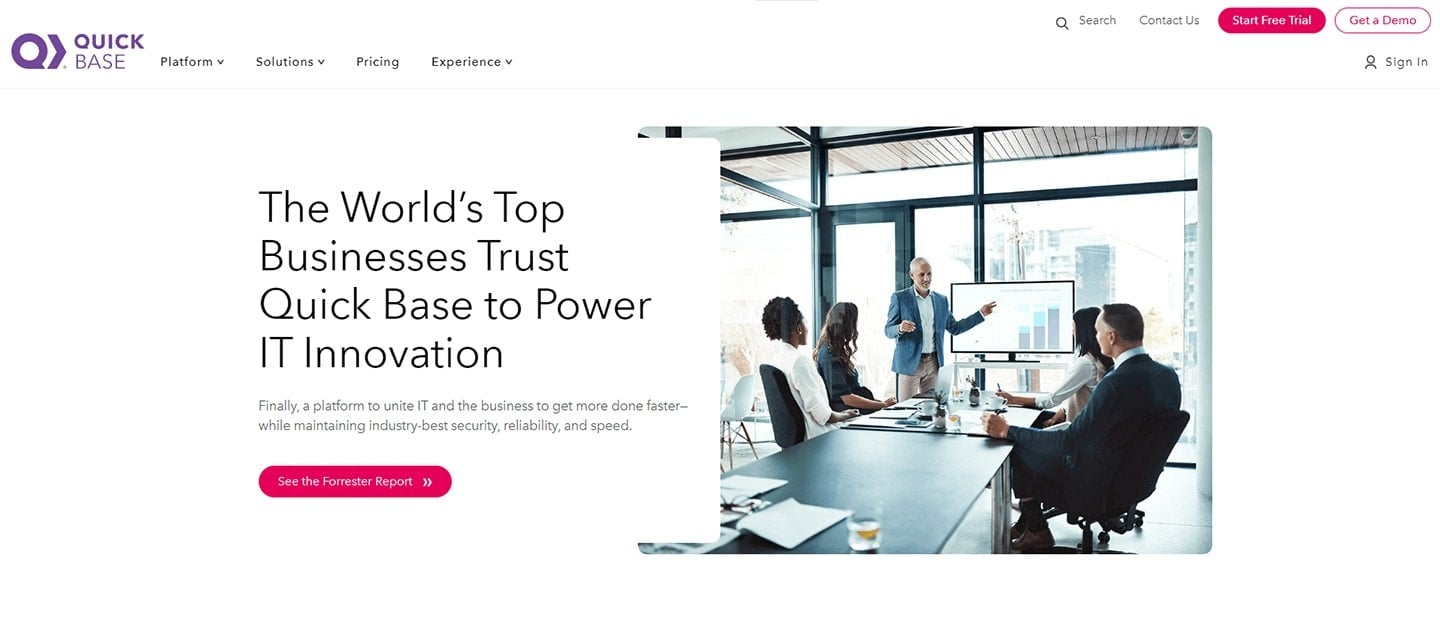
Quick Base allows users to collaborate with team members, clients, associates, and vendors. It’s built to be easy to customize without needing to know how to code.
The built-in workflows are designed to suit a wide variety of business needs so you can set up complex processes without needing much technical knowledge. It helps if you know a little bit of code, but you definitely don’t need to be a professional developer to set up the system the way you want it.
You can use Quick Base’s flexible API to create your own tech ecosystem to get more done. Since they specialize in industries with bespoke needs, the platform was created to be as flexible as you need it.
Quick Base was designed to work well in a variety of niche industries with unique business needs. However, it really shines for sensitive business models.
It’s HIPAA certified, DFARS compliant, and independently certified by several other security and regulatory organizations. If you have strict security or compliance requirements for your software systems, QuickBase is one of the few project management platforms that suits that need.
You’ll have the most success if you have a dedicated IT department to help you get set up and maintain the software, though you can do it yourself if you have the time and tech acumen. It’s probably not a good fit for smaller teams because the cost is a bit prohibitive.
Key features:
- Create custom roles and permissions so you can choose which team members see which tasks
- Manage multiple projects from one central location
- Independently certified for security and compliance by multiple organizations
- Protect your system integrity with enterprise-grade governance controls for every plan
- Connect your software suite with flexible APIs so you don’t need to rely on ready-made integrations
Pricing:
QuickBase starts at $500 per month. This price point reflects their focus on highly regulated and sensitive industries over startups and small teams.
Customer Rating in Capterra: 4.5/5
Customer Rating in G2: 4.4/5
8. Wrike
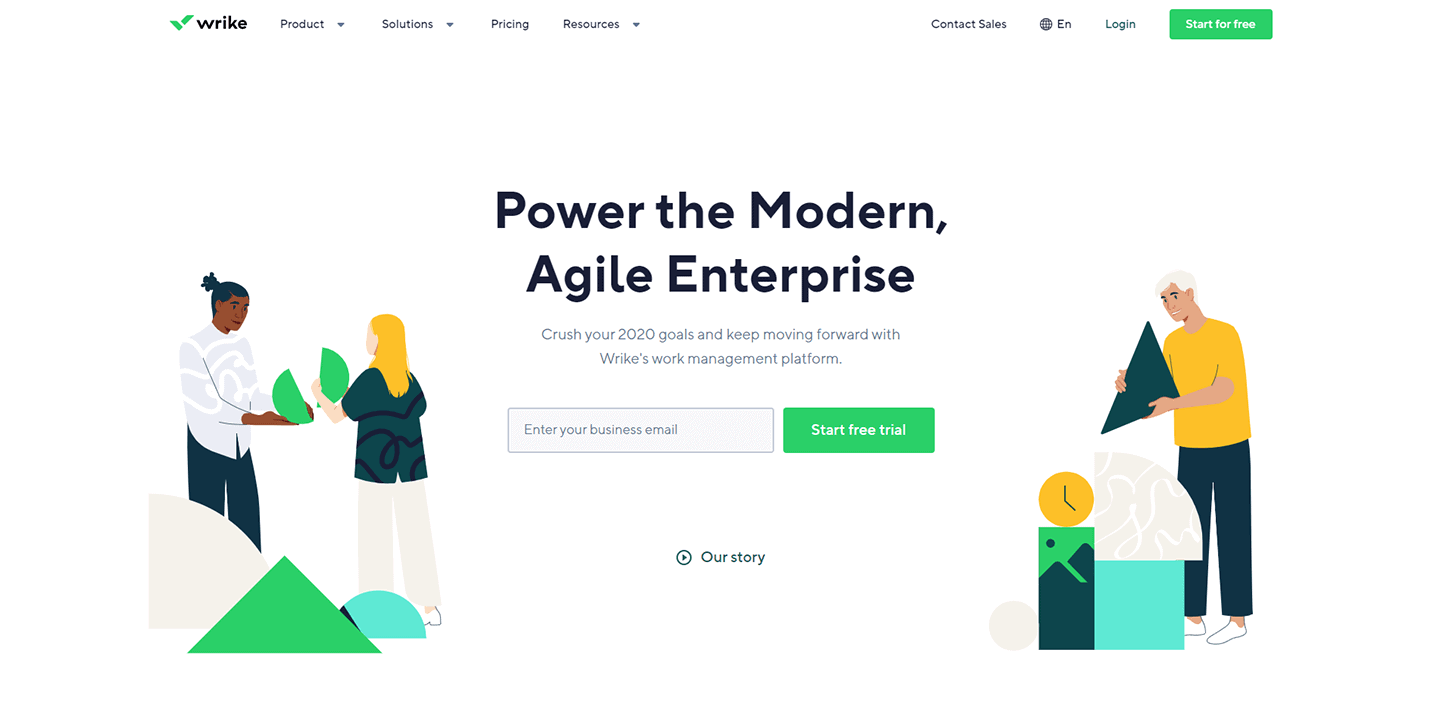
Wrike is a more flexible alternative to Trello. There’s also Wrike for Marketers, which offers some additional features designed especially for agencies and creative teams who usually struggle with developer-focused products like Trello.
Visual dashboards for each team member show you exactly who is working on what, how much progress they’ve made, and where they might need help.
You can also customize your Wrike dashboard and cut out the unneeded emails, meetings and instant messages. As soon as you log in, you see exactly what you need to work on that day.
Wrike helps you manage resources, track time, and automate some processes. Plus, it integrates with over 400 applications and the Adobe Creative Cloud.
It’s a good tool for small to mid-sized teams. With some add-ons, it becomes really powerful for creative teams who often struggle with agile project management tools.
Key features:
- Collaborate effectively with both desktop and mobile apps
- Check in with your team using real-time activity streams and clear data visualizations
- Customize your workflow to appear as a Kanban board or a Gantt chart
- Use basic time tracking to optimize how and where your team spends their time
- Keep priorities clear with customizable dashboards
Pricing:
Wrike offers a free plan with basic features for up to 5 users. Professional plans start at $9.80 per user per month for up to 15 users. With more than 15 users, you’ll need at least a Business plan at $24.80 per user per month.
Customer Rating in Capterra: 4.2/5
Customer Rating in G2: 4.2/5
9. Paymo
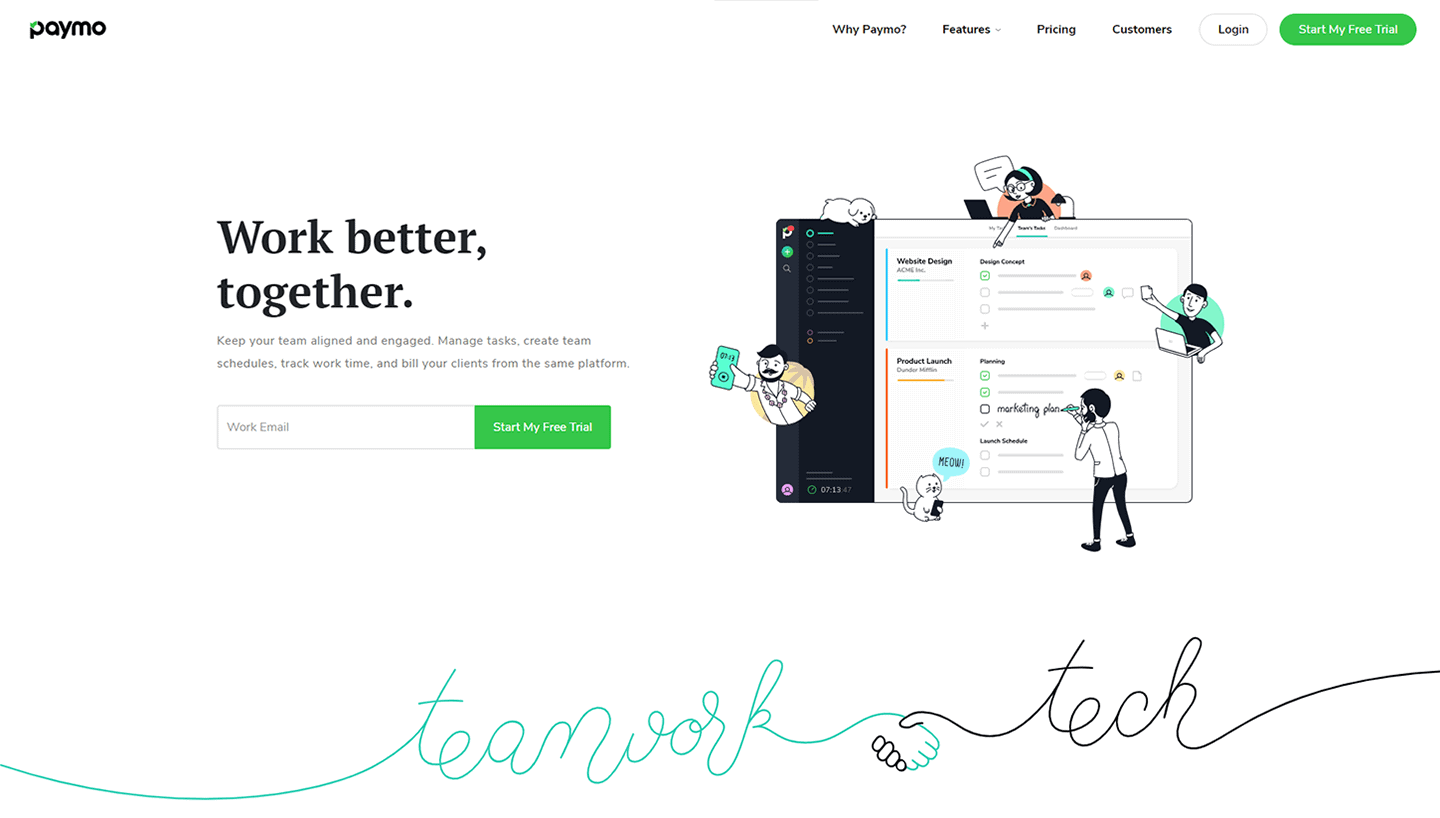
Paymo focuses on making it easy to collaborate, organize, and communicate all in one place.
The interface will feel familiar for current Trello users since it uses the popular Kanban style. You can also organize your tasks with task lists, milestones, and customizable due dates. Aps are available for Mac, Windows, iOS, and Android.
You can use Paymo to manage your timesheets, complete accounting for each project, and assign work to team members. There are plenty of reporting features to help you analyze costs and performance.
Paymo works great for freelancers because of the ability to manage projects and invoices from one system. Plus, projects can be put on hold if waiting for feedback from a client before resuming. It’s also a good choice for small to mid-sized teams who need to manage multiple projects at the same time.
Key features:
- Store files for a project so the team can access them anytime throughout the project lifecycle
- Visualize your team’s schedule to easily manage coverage, workload, and meeting time
- Using milestones, you and your team know when major project stages are due to be completed
- Save projects as templates and use them when you need to create a similar project
- Available Gantt charts give you an overview of the start date, duration, and end date between tasks
Pricing:
There’s a Free plan with basic features like to-do lists and simple reporting. This is available for solo freelancers. Team plans start at $8.95 per user per month.
Customer Rating in Capterra: 4.7/5
Customer Rating in G2: 4.7/5
Subscribe to the Hubstaff blog for more posts like this
Finding the right Trello alternative for your team
Did you find the project management tool for you? Is there a Trello alternative that you use that isn’t mentioned in our list?
Please comment below and let us know what you are using for your project management needs. You might help a team like yours find the right tool!
This post was originally published in May 2019. It was updated by the Hubstaff team in October 2020.
Most popular
How to Overcome Employee Resistance to Time Tracking: Tactics That Actually Work
Time tracking offers various benefits for teams like better planning, increased accountability, and smoother operations — but th...
The Fundamentals of Employee Goal Setting
Employee goal setting is crucial for reaching broader business goals, but a lot of us struggle to know where to start. American...
Data-Driven Productivity with Hubstaff Insights: Webinar Recap
In our recent webinar, the product team provided a deep overview of the Hubstaff Insights add-on, a powerful productivity measurem...
The Critical Role of Employee Monitoring and Workplace Security
Why do we need employee monitoring and workplace security? Companies had to adapt fast when the world shifted to remote work...



